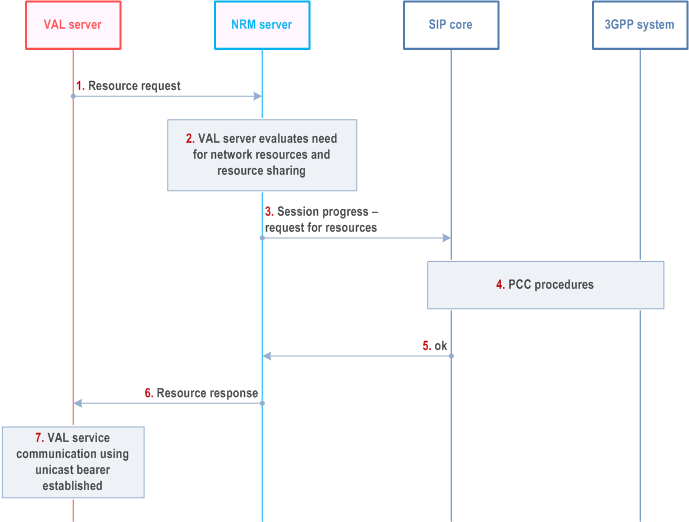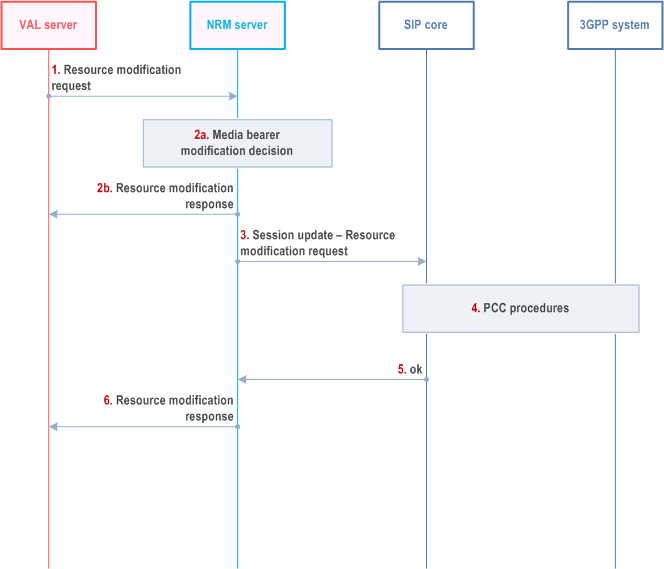Content for TS 23.434 Word version: 19.3.0
0…
4…
5
6…
6.4…
6.5…
6.5.3…
7…
8…
8.2.2…
9…
9.3…
9.3.2.21…
9.3.3…
9.3.6…
9.3.11…
9.3.13…
9.3.14…
9.4…
9.4.6…
9.5…
10…
10.3…
10.3.2.22…
10.3.3…
10.3.7…
10.3.10…
10.4…
11…
11.3…
11.3.3…
11.4…
12…
12.3…
13…
14…
14.2.2.2…
14.3…
14.3.2.20…
14.3.2.40…
14.3.3…
14.3.3.3…
14.3.4…
14.3.4.6
14.3.4.7…
14.3.4A…
14.3.4A.3…
14.3.4A.4…
14.3.4A.6…
14.3.4A.8…
14.3.4A.9…
14.3.4A.10…
14.3.5…
14.3.6…
14.3.9…
14.3.12…
14.4…
15…
16…
17…
18…
A
B…
14.3.3 Unicast resource management
14.3.3.1 General
14.3.3.2 Unicast resource management with SIP core
14.3.3.2.1 Request for unicast resources at VAL service communication establishment
14.3.3.2.2 Request for modification of unicast resources
...
...
14.3.3 Unicast resource management p. 206
14.3.3.1 General p. 206
The following subclauses specify the procedures for unicast resource management for vertical application layer. The NRM server sets up bearers and may need to modify the bearers for an already established VAL service communication.
Characteristics that may need to be modified include:
- activation and deactivation of the bearer;
- modification of the QoS characteristics of the bearer (e.g. bearer priority adjustment); and
- modification of GBR due to application requirement
14.3.3.2 Unicast resource management with SIP core p. 207
14.3.3.2.1 Request for unicast resources at VAL service communication establishment p. 207
14.3.3.2.1.1 General p. 207
The procedure defined in this subclause specifies how network resources are requested at VAL service communication establishment. If concurrent sessions are used the NRM server may utilize the capability of resource sharing specified for underlying network policy and charging functions. The request for resources includes application type, bandwidth, priority, application identifier and resource sharing information.
14.3.3.2.1.2 Procedure p. 207
The procedure is generic to any type of session establishment that requires requests for network resources.
Procedures in Figure 14.3.3.2.1.2-1 are the signalling procedures for the requesting resource at session establishment.
Pre-condition:
- The VAL client has requested VAL service communication with the VAL server.

Step 1.
The VAL server sends request for resources to the NRM server.
Step 2.
The NRM server evaluates the need for network resources and use of resource sharing.
Step 3.
The NRM server sends a session progress request containing request for resources.
Step 4.
PCC procedures are initiated from SIP core local inbound/outbound proxy.
Step 5.
The SIP core local inbound / outbound proxy sends a OK message to the NRM server.
Step 6.
The NRM server sends a resource response to the VAL server.
Step 7.
The VAL service communication is established, and resources have been allocated.
14.3.3.2.2 Request for modification of unicast resources p. 208
14.3.3.2.2.1 General p. 208
To modify unicast bearers, the NRM server shall send a resource modification request containing the parameters to be modified for the UE.
Possible scenarios when this procedure may be used are:
- Modify the allocation and retention priority for unicast resources;
- Release and resume resources in-between VAL service communications; or
- Release and resume resources when a UE is able to receive the VAL service communications over multicast transmission
14.3.3.2.2.2 Procedure p. 208
Procedures in Figure 14.3.3.2.2.2-1 are the signalling procedures for the modification of a unicast:
Pre-condition:
- A VAL service communication is already in progress;

Step 1.
The VAL server sends a resource modification request to the NRM server.
Step 2a.
The NRM server decides to modify the parameters of a unicast bearer.
Step 2b.
If the media bearer modification is not required, the NRM server sends a resource modification response to the VAL server.
Step 3.
The NRM server sends a session update which includes a resource modification request containing the modified parameters of the unicast bearer.
Step 4.
PCC procedures are initiated from SIP core local inbound/outbound proxy.
Step 5.
The SIP core local inbound / outbound proxy sends a OK message to the NRM server.
Step 6.
The NRM server sends a resource modification response to the VAL server.
Step 7.
The VAL service communication continues with the modified unicast resources.